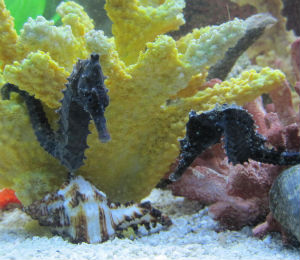Among all the wonderful things to do in Freeport Bahamas, exploring the islands’ incredible underwater world ranks high among visitor favorites. Grab your goggles and snorkel and float around off the beach or hop aboard a snorkeling tour to encounter some incredible creatures, including the fascinating little seahorse.
Seahorse Appearance
Ranging from just half an inch to a little over a foot, seahorses are upright swimmers that generally attach themselves to sea grass and other aquatic plants. Like all fish, seahorses breathe through gills, have a swim bladder and live in water; they are in in the same class as other bony fish like pipefish and sea dragons. Unlike most fish, the seahorse is covered in tiny interlocking plates and has a snout and neck that point down. Coloration varies among the various species and their habitats.
Seahorses have tiny prehensile tails for hanging on to corals and eelgrass and are very hard to spot in the wild. They live in groups called herds comprised of several hundred individuals. Though they cannot move quickly, they can maneuver easily, able to go up, down, backwards or forwards.
One of the seahorse’s unique qualities is the fact that the female places the unhatched eggs in the male’s brood patch for fertilization. Depending on the size of the species, the eggs may number anywhere between 50 and 1,500 and remain in the pouch for approximately three weeks, after which the baby seahorses, known as fry, emerge and drift off on their own.
Seahorse Eating Habits
The seahorse is omnivorous, eating both plant and animal life, grazing continuously with their tiny snouts. With no teeth and no stomach, food passes through the seahorse very rapidly, meaning they have to eat constantly in order to survive. Their diet consists mostly of algae, plankton, brine shrimp and other crustaceans.
This little creature feeds by poking its long skinny snout into nooks and crannies seeking bits of food to suck in through its thin snout. If its meal is larger than its snout, the snout itself can expand to accommodate the food. Hunting is facilitated by the seahorse’s unique visual abilities; its eyes are located on either side of the head and can work independently, enabling the fish to look forwards and backwards at the same time.
Seahorse Habitat
Seahorses live in temperate and tropical waters around the globe, mostly clinging to eel grass beds, mangrove forests and corals in shallow fresh, brackish or salt water. Tiny as they are, seahorses have an abundance of natural predators, including rays, crabs and other fish. Attached to sea grass and corals by their long, flexible tails, seahorses are easily uprooted during storms and rough weather, often cast ashore to die. Many tend to move into deeper waters in winter where they are safer from turbulent seas.
These little creatures blend in effectively with their surroundings, their natural camouflage keeping them safe from predators amid the corals and aquatic plants of their habitat. They also have little appendages called cirri all over their bodies, giving them a weed-like appearance that enhances their ability to hide among aquatic plants.
Seahorses mate for life and their courtship ritual is elaborate, sometimes lasting over an hour. As they approach each other, they entwine tails and may even change color.

